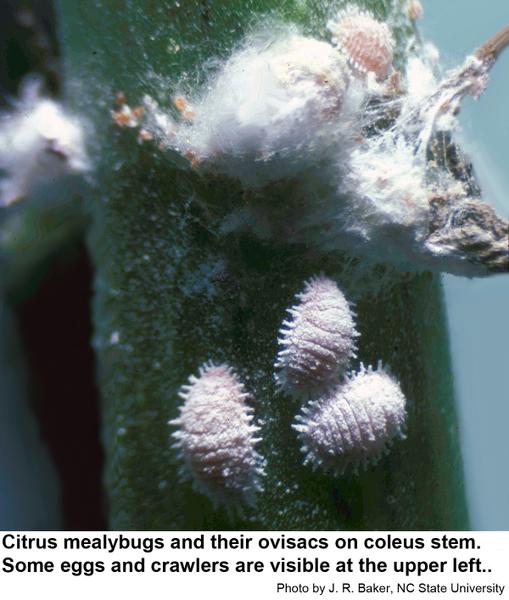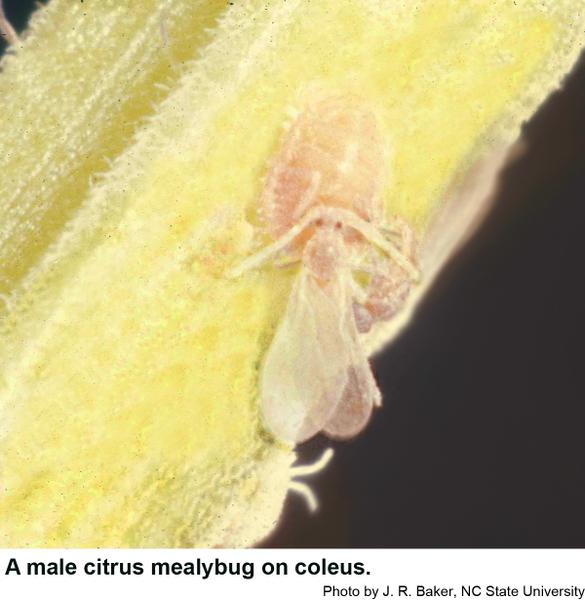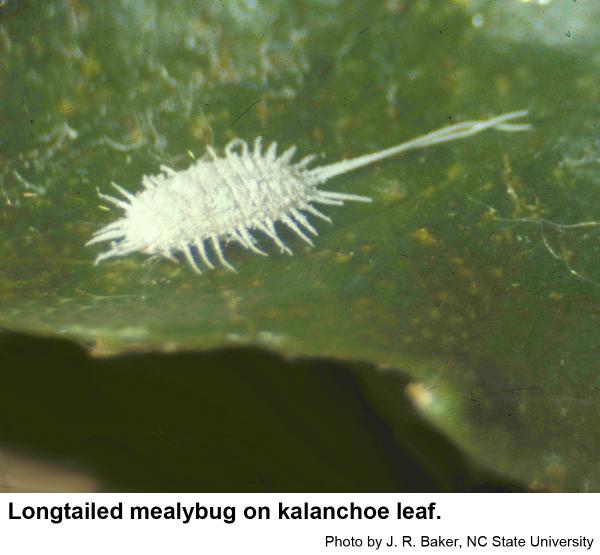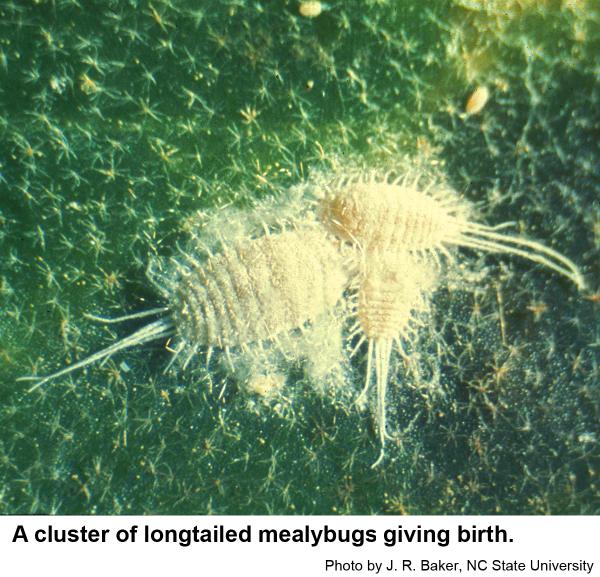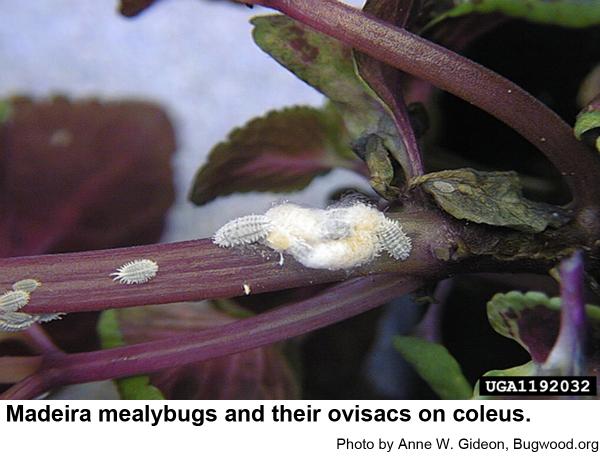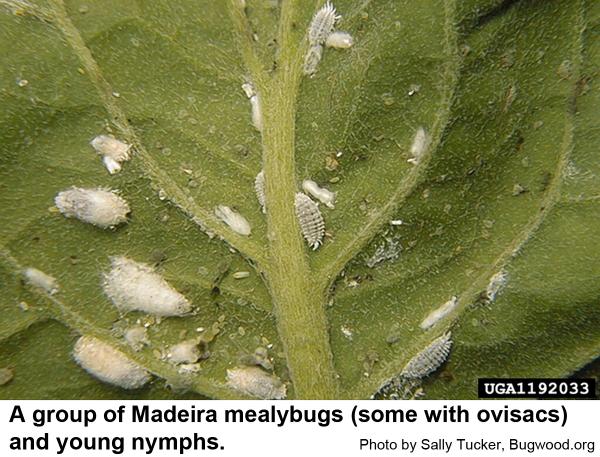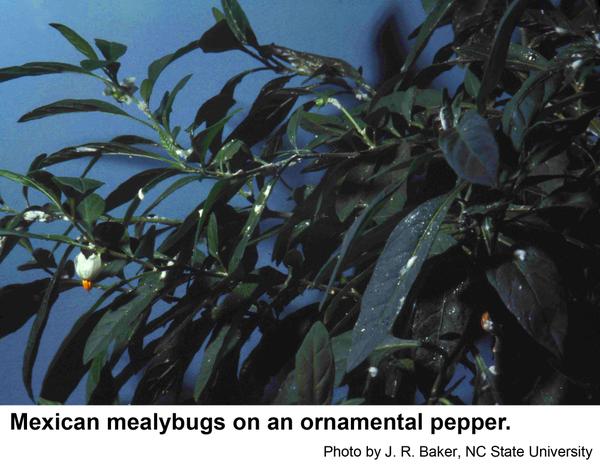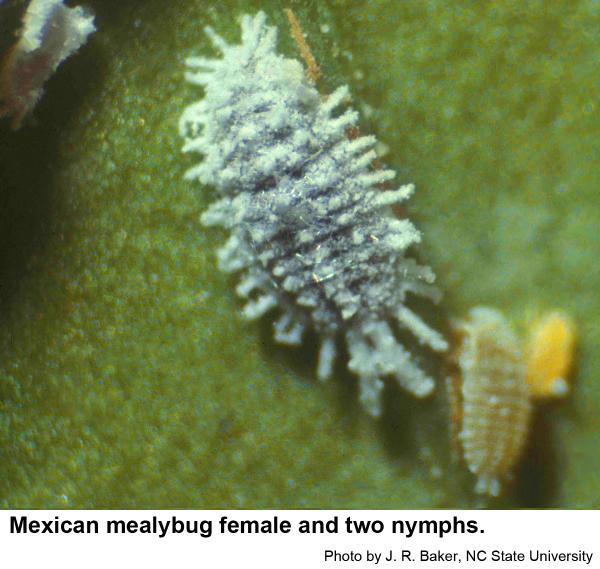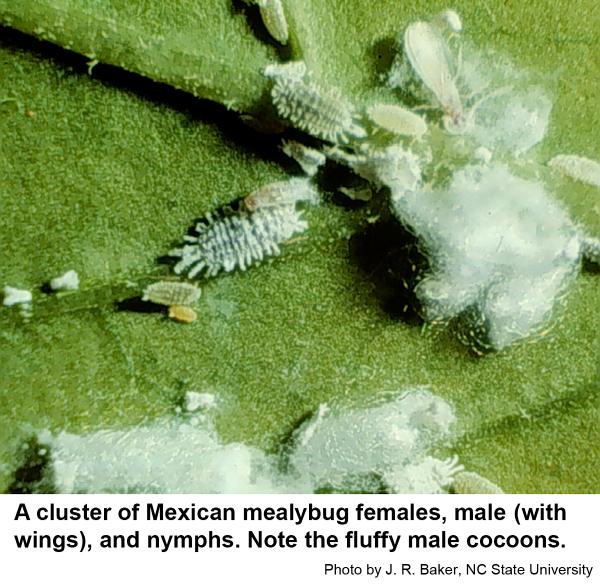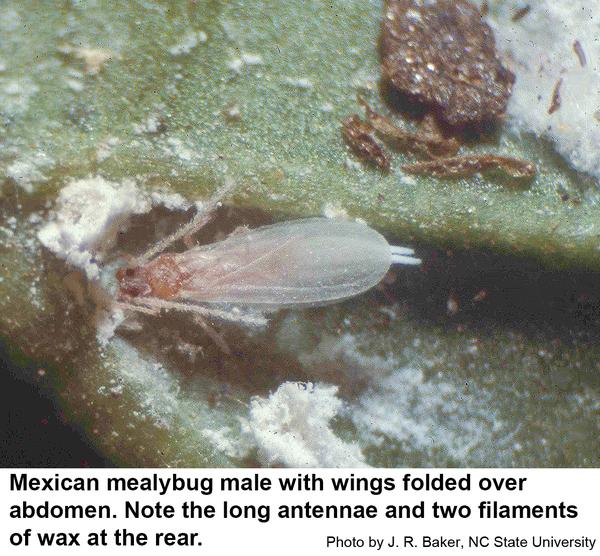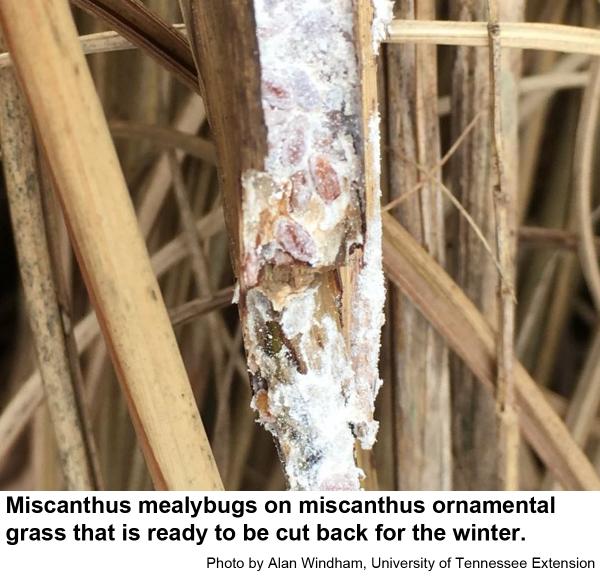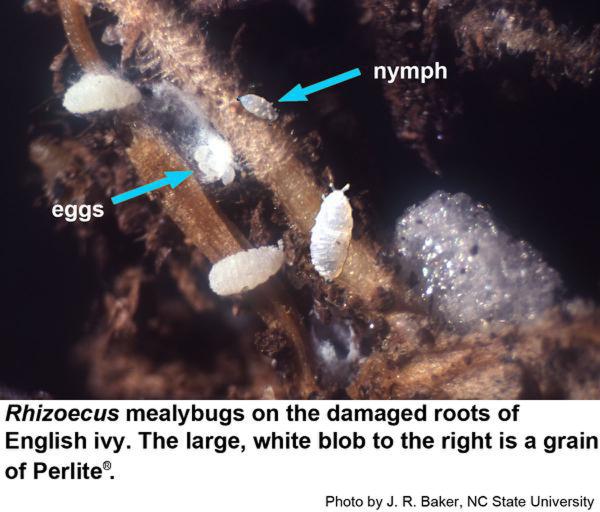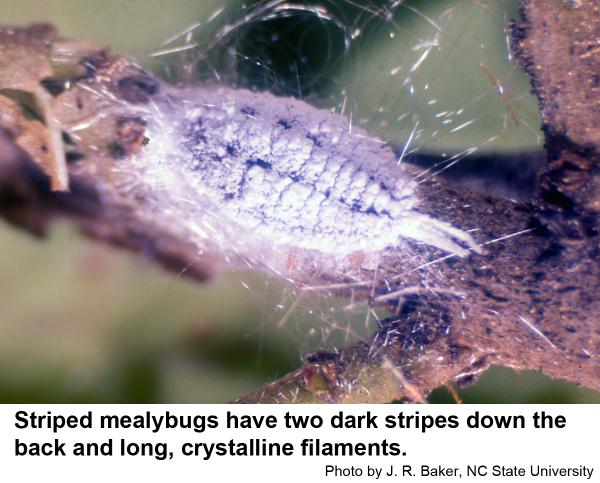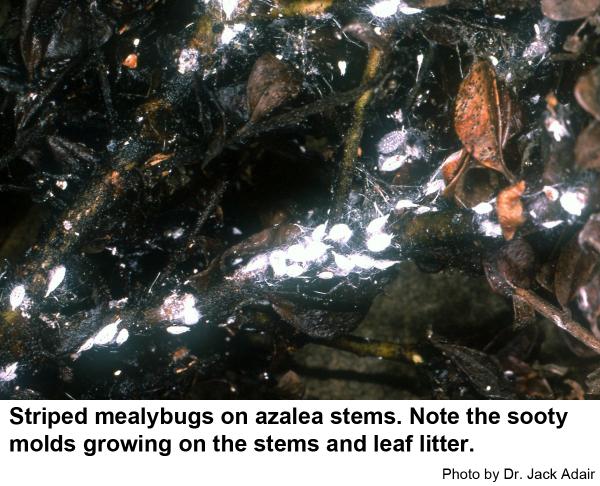General Information
Several species of mealybugs can be pests of greenhouse, nursery, and landscape plants. The most common of these are the citrus mealybug and longtailed mealybug though other species including Madeira mealybug, miscanthus mealybug, and various root mealybugs also occur. In general mealybugs cause similar damage symptoms and are managed in similar ways. Female mealybugs are soft oval insects without wings. They are up to 3mm long. Some species are covered with fluffy wax and others have long, tails of fluffy wax. Male mealybugs are tiny, gnatlike insects with four eyes, two wings and long tails of white wax. Mealybug eggs are very small but and covered by a conspicuous dense, fluffy, white mass of wax called the ovisac. Very young nymphs are flat, oval and yellow. Older nymphs of some species are covered with fluffy, white wax.
Biology
Mealybugs are pests of ornamental crops indoors and outdoors across the world. They are most active in warm, dry weather. Most species of ornamental plants can be infested with mealybugs. Mealybugs damage plants by inserting their threadlike mouthparts into any part of the plant and sucking out sap. Mealybugs excrete honeydew, a sweet, sticky liquid. Sooty molds often grow in the honeydew causing infested plants to turn black. The citrus mealybug has a toxin in its saliva which causes its host plants to drop leaves and buds. Heavily infested plants are disfigured by the mealybugs, their ovisacs, honeydew and sooty molds.
Female mealybugs have no wings and must be transported directly to or near the next host plant. They can travel short distances by crawling or the very young nymphs may be blown about by the wind or carried on the feet of birds. Small numbers of mealybugs are easily overlooked as they tend to wedge into crevices on plants. Mealybugs are usually found at the base of stems (or petioles of plants with long petioles such as African violets). After the first batch of eggs hatch, the infestation becomes very noticeable. As their numbers increase, mealybugs of all sizes can be found crawling around or feeding on all surfaces of the plant.
Each female usually lays from 200 to 600 eggs in the thick ovisac. Some species of mealybugs give birth to live young. After several weeks, the nymphs develop into adults. Male nymphs secrete a tiny, fluffy cocoon and develop into winged adults. Males then fly about seeking females to mate with.
Citrus Mealybug
Because female citrus mealybugs, Planococcus citri, have no wings, they must be transported to the proximity of the next host plant. Females are oval in top view and are usually covered with a fluffy, white secretion. Sometimes they have a slightly darker line down the back. Females can travel short distances by crawling or they can be carried by ants. Outdoors the immatures can be blown about. The males pupate in a fluffy cocoon of wax. Males are small, winged insects. After mating, each female lays 300 to 600 eggs in a dense, fluffy secretion called the egg sac or ovisac. Within a few days, new mealybugs (crawlers) hatch and begin to squirm out of the ovisac. After six to ten weeks, a new generation of adults is ready to continue the wheel of existence. Light infestations are easily overlooked because mealybugs tend to wedge into crevices on the host plant. As their numbers increase, citrus mealybugs of all sizes can be seen crawling around or feeding on all exposed plant surfaces although they tend to clump together.
Citrus mealybugs have been collected from at least 27 host plant families. Many ornamental plants grown in greenhouses, homes, and gardens are susceptible to attack including begonia, coleus, amaryllis, cyclamen, and dahlia. Citrus mealybug has been collected on canna, narcissus, and tulip outdoors. Outdoors, citrus mealybugs do not survive our winters here in North Carolina. Mealybugs suck out sap and excrete honeydew, a sweet sticky liquid. Citrus mealybugs lay eggs in a dense, waxy mass called the ovisac. The males pupate in a fluffy cocoon of wax. Thus the mealybugs, honeydew, male cocoons, and the ovisacs disfigure infested plants. Not only that, but as the mealybugs feed, they inject their saliva into the plant. Some plants are very sensitive to citrus mealybug saliva, which causes stunting, wilting, or even dieback when large numbers of mealybugs are feeding.
Longtailed Mealybug
Female longtailed mealybugs, Pseudococcus longispinus, have 17 pairs of waxy filaments around the periphery and are up to 1/8 inch long. On mature specimens, the caudal (tail) filaments are as long as or longer than the yellowish to grayish body (unless the tail filaments have broken off). Overall length maybe 1/4 inch. Nymphs are similar to the larger adult female except that the filaments around the edges are shorter. Most species of mealybugs lay eggs in a dense, waxy mass called the ovisac, but the eggs of the longtailed mealybug hatch almost immediately so that they appear to be born alive. The males pupate in a fluffy cocoon of wax. Although longtailed mealybugs were first described in 1867, not much has been published on their biology. Females appear to give birth to live young on a shallow pile of white waxy secretions. Because the females are wingless, they must be brought into proximity of a host plant before it can be infested.
Longtailed mealybugs have been found on at least 26 plant families. Dracaena appears to be the favored host, but most flowering and ornamental foliage plants are susceptible. Mealybugs suck out sap and excrete honeydew, a sweet sticky liquid. The mealybugs, honeydew, male cocoons, and the ovisacs disfigure infested plants. Not only that, but as the mealybugs feed, they inject their saliva into the plant. Some very sensitive plants may wilt and die when large numbers of longtailed mealybugs are feeding.
Madeira Mealybug
Madeira mealybugs, Phenacoccus madeirensis, are separable from Mexican mealybugs primarily by microscopic characters. In general, Madeira mealybugs are a little grayer and have slightly less exuberant tufts of white, fluffy secretions on the top. In a greenhouse, Madeira mealybugs have five to six generations per year. At least 38 eggs are laid in a dense ovisac from which nymphs hatch and develop into fliteless females or tiny, gnat-like males. Females take from a month at high temperatures to a little more than two months at lower temperatures to develop from egg to adult. Males take 3 to 9 days longer. Typically, half of the population is female.
This mealybug has been collected from 45 plant families including many ornamental plants and well as vegetable, fruit, and field crops. Madeira mealybugs sometimes cause stunted growth, deformed leaves, and enough honeydew in which sooty molds grow and further disfigure plants.
Mexican Mealybug
Female Mexican mealybugs, Phenacoccus gossypii, are almost 3/16 inch long, oval, grayish and covered with a thin, white, waxy secretion. They have three parallel rows of small waxy tufts down the back. This insect is a short-tailed mealybug (the tail filaments do not exceed 1/4 the body length). The lateral filaments are also short. Males are tiny gnatlike insects with two wings, four eyes, and four waxy filaments at the rear. The ovisac (egg sac) is white, dense, narrow, and eventually longer than the female producing it. Females lay up to 400 eggs. The eggs hatch in 6 to 14 days. Nymphs are small, yellowish, and have white waxy secretions that eventually resemble those of adults. Males have only two nymph stages and then a prepupal and pupal stage. They generally fly after dark. Females have three nymph stages. Under greenhouse conditions, development from egg to adult female takes about 47 days. There is some debate about the identity of Mexican mealybugs in the eastern US. The original distribution is southwestern US and Mexico. However, with the importation of many species of plants from California into North Carolina, it seems likely that some of our Phenacoccus mealybugs are genuinely Mexican mealybugs.
The Mexican mealybug is found commonly on numerous ornamental plants, a few of which are Aralia, chrysanthemum, English ivy, geranium, Gynura, hollyhock, Ixia, lantana, and poinsettia. This insect is also a minor pest of lima beans in the warmer parts of the United States. Heavily infested plants become wilted, stunted, and dark with sooty molds that grow in honeydew excreted by the mealybugs. The mealybugs themselves as well as their ovisacs also disfigure heavily infested plants.
Miscanthus mealybug
Miscanthus mealybugs, Miscanthiococcus miscanthi, is a pest of ornamental grasses in the genus Miscanthus. They cause yellowing and twisting of leaves, stunted, unthrifty plants with reduced flower production and flower stem elongation, and slowing down of plant growth.Miscanthus mealybug can also damage plants by excreting the sticky honeydew which is a substance for the black sooty mold fungus growth. Miscanthus mealybugs may be hidden within the leaf sheaths of the crown of these plants, which would cause them to be overlooked in the landscape or nursery and they also infest the roots. The colony is often tightly packed and white, powdery waxy material and small amounts of honeydew may be present in it. Miscanthus mealybugs can reduce plant vigor and attractiveness. Fortunately, they induce purple spots on infested stems, which is a good indicator of a potential infestation. Adult females overwinter and crawlers usually emerge by May. Three generations occur per year, and crawlers of each generation take three to four weeks to mature. Miscanthus mealybug can be spread by propagating infested plants or when emerging crawlers are blown onto nearby plants. Aside from pesticides, 99 percent control of Miscanthus mealybug can be achieved by immersing container-grown miscanthus in water heated to 120˚ F for 15 minutes. Some plants are injured by such heat treatment so testing on a small portion of the crop is recommended.
Rhizoecus or Root Mealybugs
Root mealybugs in the genus Rhizoecus have adapted to subterranean life. These include the ground mealybug, Rhizoecus falcifer, Rhizoecus americanus, and the newly introduced hibiscus mealybug, Rhizoecus hibisci. One of the most familiar root mealybugs in North Carolina is Pritchard's mealybug, Rhizoecus pritchardi, that feeds on the roots of African violets and other plants. These root mealybugs differ only in microscopic characters. Adult females are 1/16 to about 1/8 inch long, slightly flattened, and rounded on each end. The body is bluish white but covered with a shallow, white, fluffy bloom. They might be mistaken for large, white springtails but move much more slowly. Some species even secrete slender filaments that form a netting over the insect. They also secrete a powdery, white fluff that gives the soil a bluish tint. These mealybugs almost or completely lack eyes, and the antennae are short. Females lay at least six eggs in a fluffy, white sort of nest. The nymphs resemble females but are smaller. When potted plants are irrigated, root mealybugs sometimes crawl out of the drainage holes and infest plants nearby. Root mealybugs feed on the roots of ornamental plants including Achillea, African violet, anemone, Arctostaphylos, bamboo, Bermuda grass and other ornamental grasses, chrysanthemum, Geum, ginger, gladiolus, iris, hibiscus, Polygala, Robinia, and palms including queen, majesty, fishtail, triangle, kentia, lady, pygmy date, and MacArthur palms.
Striped Mealybug
The striped mealybug, Ferresia virgata, is one of the showier mealybugs. Females are up to 3/16 inches long, and covered with a fluffy, white secretion except for two dark stripes down the back. This mealybug also has slender, clear, hairlike secretions protruding through the fluff as well as two long, white, tail filaments. Males have two wings, long antennae, well developed legs, and a pair of long, white filaments at the rear. Males do not have mouthparts and live only three or four days. Over a period of 20 to 29 days, each females lays 64 to 737 eggs on a pad of fluffy filaments underneath her. Eggs hatch 30 minutes to 4 hours later. Female nymphs molt three times and male nymphs molt four times before molting into the adult stage a month or two later. Striped mealybugs often cluster around terminal shoots and leaves. During cold weather, females crawl down into the soil beneath their host plants
Striped mealybugs have been reported from over over 203 genera of plants in 77 families including field crops, vegetable crops, fruit crops, and ornamental crops. In North Carolina, we have seen it primarily on landscape azaleas and yaupon holly. Heavy infestations result in yellowing, withering and drying of plants as well as premature leaf drop. They sometimes excrete enough honeydew to disfigure foliage with resulting sooty molds. Sooty molds sometimes become so dense that they reduce photosynthesis and plant vigor.
Control
Mealybugs are not easy to control. This is because the eggs are enmeshed in waxy fluff and thus relatively water proof. Likewise adults and nymphs can be covered in wax to varying extents and obscured in plant nooks and crannies where it is difficult to get thorough pesticide coverage.
For this reason systemic insecticides may offer the most reliable control because they make the plant toxic to feed on rather than relying on contacting the insect directly. If a contact insecticide is used be prepared to repeat the applications two or more times to kill nymphs that hatch from protected eggs and adults or nymphs that were protected by plant tissue. If an infestation is discovered early enough on a few cherished house plants, the mealybugs may be removed by a cotton swab dipped in alcohol or fingernail polish remover. Keep an eye on the plants for a few weeks to make sure no mealybugs are overlooked.
For more insecticide options consult the North Carolina Agricultural Chemicals Manual.
Other Resources
- Alternatives to a Pyrethroid for Controlling Madeira Mealybug (Hemiptera: Pseudococcidae) on Coleus Cuttings. Espinoza-Lozano, L. et al. Florida Entomologist 101(3): 389-394.
- A Revision of the New World Mealybugs of the Genus Rhizoecus, (Homoptera: Pseudococcidae). Hambelton, E. J. 1976. USDA Technical Bulletin No. 1522.
- Common name: citrus mealybug, scientific name: Planococcus citri (Risso) (Insecta: Hemiptera: Pseudococcidae). Gill, H. K., G. Goyal, and J. L. Gillett-Kaufman. 2012. Featured Creatures, Entomology & Nematology, ACS/DPI, EDIS.
- Common name: striped mealybug, scientific name: Ferrisia virgata Cockerell (Insecta: Hemiptera: Pseudococcidae). McCorquodale, A. and A. Hodges. 2016. Entomology & Nematology, FDACS/DPI, EDIS. Publication Number: EENY-674.
- Ferrisia virgata (striped mealybug). Anonymous. 2018 (last modified). CABI Invasive Species Compendium Data Sheet.
- Insect and Related Pests of Flowers and Foliage Plants. Baker, J. R. ed. 1994 (revised). NC Cooperative Extension Service pub. AG-136.
- Mealybugs. Osborne, L. S. 2015 (revised). Mid-Florida Research and Education Center.
- Mealybugs of California. McKenzie, H. H. 1967. Univ. California Press. Berkely and Los Angeles. 525 pp.
- Miscanthus Mealybug, Miscanthicoccus miscanthi (Takahashi): A New Pest of Ornamental Grasses in Tennessee. Hale, F. A. and D. Cook. 2009. SNA Research Conference Vol 54: 153-154.
- Phenacoccus madeirensis Green (Hemiptera: Pseudococcidae), a recently introduce exotic pest in Japan. Kondo, T., T. Esato, and S. Kawai. 2001. Bollettino di Zoologia agraria e di Bachicoltura, Ser. II, 33 (3): 337-341.
- Root Mealybugs of Quarantine Significance in Hawaii. Hara, A. H. et al 2001. College of Tropical Agriculture & Human Resources Cooperative Extension Service.
- State of the Art on Adaptability of Miscanthiococcus miscanthi Takaschi (Homopter, Pseudococcidae) Followed by the Introduction of Miscanthus X giganteus to Ukraine. Stefanovska, T., P. et al. 2017. Comm. Appl. Biol. Sci, Ghent University, 82/2: 177-181.
- Temperature Effects on the Development, Survival, and Reproduction of the Madeira Mealybug, Phenacoccus madeirensis Green (Hemiptera: Pseudococcidae), on Chrysanthemum. Chong, J.- H., R. D. Oetting, and M. W. Van Iersel. 2003. Annals Entomological Society of America 96 (4): 539–543.
- Extension Plant Pathology Publications and Factsheets
- Horticultural Science Publications
- North Carolina Cooperative Extension
For assistance with a specific problem, contact your local Cooperative Extension Center.
Publication date: Aug. 1, 2010
Reviewed/Revised: Sept. 27, 2022
Recommendations for the use of agricultural chemicals are included in this publication as a convenience to the reader. The use of brand names and any mention or listing of commercial products or services in this publication does not imply endorsement by NC State University or N.C. A&T State University nor discrimination against similar products or services not mentioned. Individuals who use agricultural chemicals are responsible for ensuring that the intended use complies with current regulations and conforms to the product label. Be sure to obtain current information about usage regulations and examine a current product label before applying any chemical. For assistance, contact your local N.C. Cooperative Extension county center.
N.C. Cooperative Extension prohibits discrimination and harassment regardless of age, color, disability, family and marital status, gender identity, national origin, political beliefs, race, religion, sex (including pregnancy), sexual orientation and veteran status.

